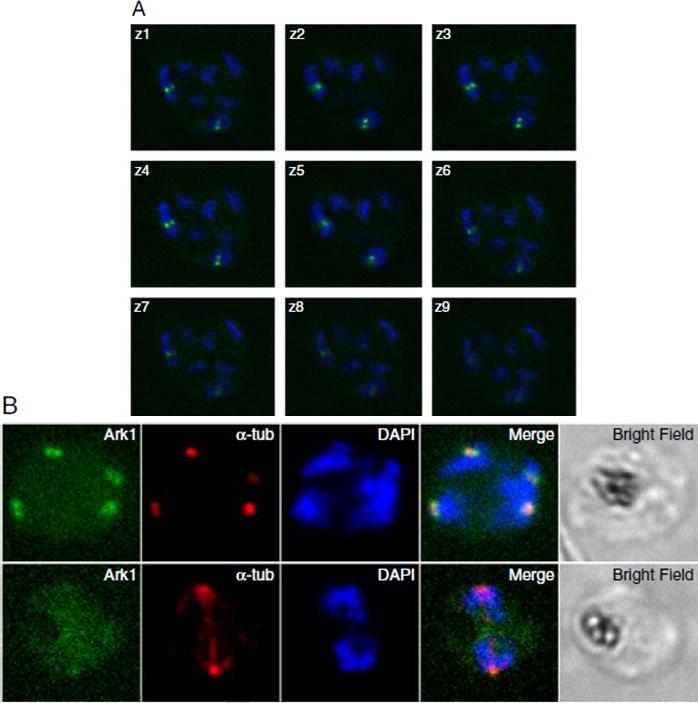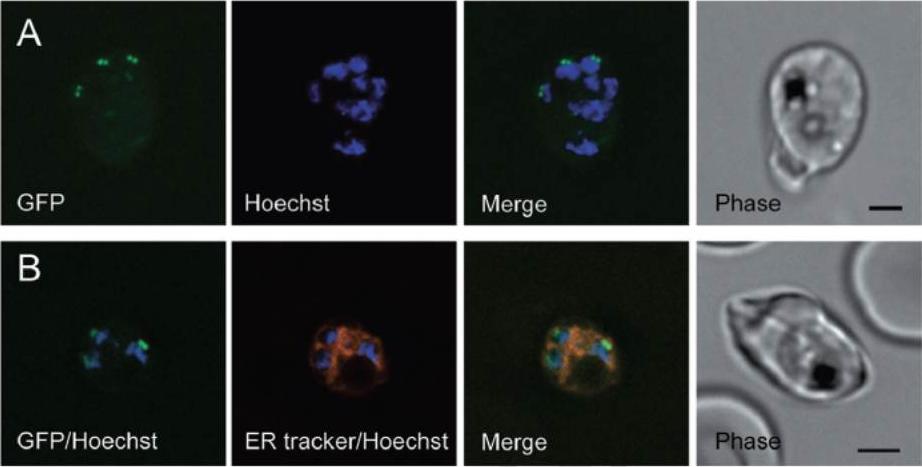PBANKA_0104100 serine/threonine protein kinase, putative (ARK1)
Disruptability [+]
| Species | Disruptability | Reference | Submitter | |
|---|---|---|---|---|
| P. berghei ANKA |
Refractory |
RMgm-550 | Imported from RMgmDB | |
| P. falciparum 3D7 |
Refractory |
22127061 | Theo Sanderson, Wellcome Trust Sanger Institute | |
| P. falciparum 3D7 |
Refractory |
USF piggyBac screen (Insert. mut.) | USF PiggyBac Screen | |
| P. falciparum 3D7 |
Refractory |
21166904 | Theo Sanderson, Francis Crick Institute | |
Mutant phenotypes [+]
None reported yet. Please press the '+' button above to add one.Imaging data (from Malaria Metabolic Pathways)

Pfark-1 expression in schizont stage P. falciparum parasites. A. Z-stacks live images of Pfark-1-GFP transgenic parasite undergoing schizogony showing the presence of pairs of dots (green) restricted to two out of seven nuclei (blue), reflecting the asynchrony of nuclear multiplication in schizont stage malaria parasites. B. Immunofluorescence assay of Pfark-1-GFP transgenic parasites. The upper panel shows that the Pfark-1-GFP protein is observed as pairs of dots (green) in close vicinity to DAPI-stained nuclear bodies (blue). Anti-α-tubulin antibody (DM1A) recognizes short intranuclear microtubule spindles (red) which appear between duplicated spindle pole bodies. The lower panel shows the absence of Pfark1-GFP protein at the spindle poles when fully developed spindle microtubules are visible.Doerig C, Reininger L. Nima- and Aurora-related kinases of malaria parasites. Biochim Biophys Acta. 2013 1834(7):1336-45. Copyright Elsevier
See original on MMP
Subcellular localization of Pfark-1–GFP. Live images of schizont stage P. falciparum transgenic parasites expressing the Pfark-1–GFP protein. A. Parasites stained with Hoechst 33258. The localization of C-terminally GFP-tagged Pfark-1 protein (green signal) was observed as paired dots in close proximity to Hoechst-stained nuclear DNA (blue). B. Parasites stained with Hoechst 33258 and ER-tracker. The ER forms a highly developed membranous system from trophozoite to schizont stage. The superimposed images show that the GFP-tagged Pfark-1 protein (green dots) localize to the edge of the nuclear DNA (blue) and the ER/nuclear membrane (red), suggesting a localization of Pfark-1–GFP in contact with the nuclear envelope.Reininger L, Wilkes JM, Bourgade H, Miranda-Saavedra D, Doerig C. An essential Aurora-related kinase transiently associates with spindle pole bodies during Plasmodium falciparum erythrocytic schizogony. Mol Microbiol. 2011 79(1):205-21.
See original on MMP
Colocalization experiments of Pfark-1–GFP with a-tubulin. Fluorescence microscopy of fixed schizont stage transgenic parasites expressing Pfark-1–GFP. A and B. An anti-a-tubulin mAb recognizes discrete foci (red) near DAPI-stained nuclear DNA (blue). The red fluorescent pattern is consistent with early-stage mitotic spindle formation developing from the spindle pole bodies anchored in the nuclear membrane. In colour merge images, the Pfark-1–GFP protein appears to localize at opposite sides of the early mitotic spindle, consistent with a localization at the mitotic spindle poles. C and D. In these two panels the anti-a-tubulin mAb recognizes partly disassembled bipolar mitotic spindles (red) aligned with DAPI-stained nuclear bodies (blue), representing daughter nuclear bodies in the process of completion of nuclear division. The Pfark-1–GFP protein does not appear now to be confined to mitotic spindle poles. A diffuse cytosolic green fluorescence is observable, presumably representing the GFP degradation product observed by Western blot analysis.Reininger L, Wilkes JM, Bourgade H, Miranda-Saavedra D, Doerig C. An essential Aurora-related kinase transiently associates with spindle pole bodies during Plasmodium falciparum erythrocytic schizogony. Mol Microbiol. 2011 79(1):205-21.
See original on MMPMore information
| PlasmoDB | PBANKA_0104100 |
| GeneDB | PBANKA_0104100 |
| Malaria Metabolic Pathways | Localisation images Pathways mapped to |
| Previous ID(s) | PB000863.02.0, PBANKA_010410 |
| Orthologs | PCHAS_0104700 , PF3D7_0605300 , PKNH_1145200 , PVP01_1143600 , PVX_113435 , PY17X_0105600 |
| Google Scholar | Search for all mentions of this gene |